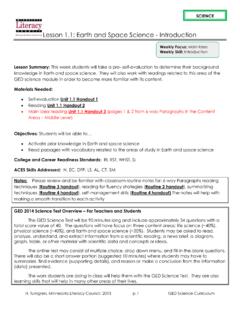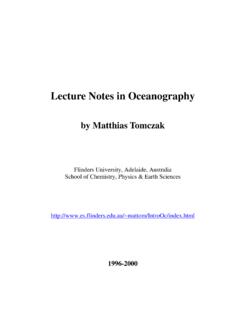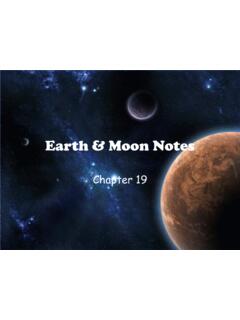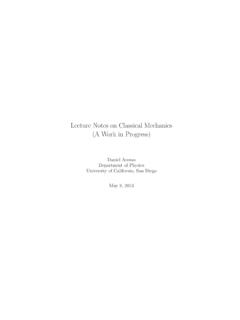Transcription of Chapter 1 Introduction to Earth Science - jkaser.com
1 Chapter 1 Introduction to Earth Science Section 1 What Is Earth Science ? Key Concepts What is the study of Earth Science ? How did Earth and the solar system form? Vocabulary Earth Science geology oceanography meteorology astronomy Overview of Earth Science Earth Science is the name for the group of sciences that deals with Earth and its neighbors in space. Earth Science includes many subdivisions of geology such as geochemistry, geophysics, geobiology and paleontology, as well as oceanography, meteorology, and astronomy. Units 1 through 4 focus on the Science of geology, a word that means study of Earth . Geology is divided into two broad areas physical geology and historical geology.
2 Physical geology includes the examination of the materials that make up Earth and the possible explanations for the many processes that shape our planet. Processes below the surface create earthquakes, build mountains, and produce volcanoes. Processes at the surface break rock apart and create different landforms. Erosion by water, wind, and ice results in different landscapes. You will learn that rocks and minerals form in response to Earth 's internal and external processes. Understanding the origin of rocks and minerals is an important part of understanding Earth . In contrast to physical geology, the aim of historical geology is to understand Earth 's long history. Historical geology tries to establish a timeline of the vast number of physical and biological changes that have occurred in the past.
3 See Figure 1. We study physical geology before historical geology because we must first understand how Earth works before we try to unravel its past. Figure 1 Scientists called paleontologists study fossils, which are signs of life in the distant past, to find out how life-forms have changed through time. Posing Questions What questions do you have about this fossil? Unit 5 is devoted to oceanography. Oceanography integrates the sciences of chemistry, physics, geology, and biology. Oceanographers study the composition and movements of seawater, as well as coastal processes, seafloor topography, and marine life. See Figure 2. Figure 2 Oceanographers study all aspects of the ocean the chemistry of its waters, the geology of its seafloor, the physics of its interactions with the atmosphere, and the biology of its organisms.
4 Unit 6 examines the composition of Earth 's atmosphere. The combined effects of Earth 's motions and energy from the sun cause the atmosphere to produce different weather conditions. This, in turn, creates the basic pattern of global climates. Meteorology is the study of the atmosphere and the processes that produce weather and climate. Like oceanography, meteorology also involves other branches of Science . Unit 7 demonstrates that understanding Earth requires an understanding of Earth 's position in the universe. The Science of astronomy, the study of the universe, is useful in probing the origins of our own environment. All objects in space, including Earth , are subject to the same physical laws.
5 Learning about the other members of our solar system and the universe beyond helps us to understand Earth . Throughout its long existence, Earth has been changing. In fact, it is changing as you read this page and will continue to do so. Sometimes the changes are rapid and violent, such as when tornados, landslides, or volcanic eruptions occur. Many changes, however, take place so gradually that they go unnoticed during a lifetime. Formation of Earth Earth is one of nine planets that revolve around the sun. Our solar system has an orderly nature. Scientists understand that Earth and the other planets formed during the same time span and from the same material as the sun.
6 The nebular hypothesis suggests that the bodies of our solar system evolved from an enormous rotating cloud called the solar nebula. It was made up mostly of hydrogen and helium, with a small percentage of heavier elements. Figure 3 on page 4 summarizes some key points of this hypothesis. High temperatures and weak fields of gravity characterized the inner planets. As a result, the inner planets were not able to hold onto the lighter gases of the nebular cloud. The lightest gases, hydrogen and helium, were whisked away toward the heavier planets by the solar wind. Earth , Mars, and Venus were able to retain some heavier gases including water vapor and carbon dioxide. The materials that formed by outer planets contained high percentages of water, carbon dioxide, ammonia, and methane.
7 The size and frigid temperatures of the outer planets provided the surface gravity to hold these heavier gases. Layers Form on Earth Shortly after Earth formed, the decay of radioactive elements, combined with heat released by colliding particles, produced some melting of the interior. This allowed the denser elements, mostly iron and nickel, to sink to Earth 's center. The lighter, rocky components floated outward, toward the surface. This sinking and floating is believed to still be occurring, but on a much smaller scale. As a result of this process, Earth 's interior is not made of uniform materials. It consists of layers of materials that have different properties. An important result of this process is that gaseous materials were allowed to escape from Earth 's interior, just as gases escape today during volcanic eruptions.
8 In this way, an atmosphere gradually formed along with the ocean. It was composed mainly of gases that were released from within the planet. Section 2 A View of Earth Key Concepts What are the four major spheres into which Earth is divided? What defines the three main parts of the solid Earth ? Which model explains the position of continents and the occurrence of volcanoes and earthquakes? Vocabulary hydrosphere atmosphere geosphere biosphere core mantle crust Earth 's Major Spheres The view of Earth shown in Figure 5B should help you see why the physical environment is traditionally divided into three major spheres: the water portion of our planet, the hydrosphere; Earth 's gaseous envelope, the atmosphere; and the geosphere.
9 Figure 5 A View that greeted the Apollo 8 astronauts as their spacecraft emerged from behind th Moon. B Africa and Arabia are prominent in this image of Earth taken from Apollo 17. The tan areas are desert regions. The bands of clouds over central Africa are associated with rainforests. Antarctica, which is covered by glacial ice, is visible at the south pole. The dark blue oceans and white swirling clouds remind us of the importance of oceans and the atmosphere. Our environment is characterized by the continuous interactions of air and rock, rock and water, and water and air. The biosphere, which is made up of all the life-forms on Earth , interacts with all three of these physical spheres.
10 Earth can be thought of as consisting of four major spheres: the hydrosphere, atmosphere, geosphere, and biosphere. Hydrosphere Water is what makes Earth unique. All of the water on Earth makes up the hydrosphere. Continually on the move, water evaporates from the oceans to the atmosphere, falls back to Earth as rain, and runs back to the ocean. The oceans account for approximately 97 percent of the water on Earth . The remaining 3 percent is fresh water and is present in groundwater, streams, lakes, and glaciers. Although these freshwater sources make up a small fraction of the total amount of water on Earth , they are quite important. Streams, glaciers, and groundwater are responsible for sustaining life and creating many of Earth 's varied landforms.















